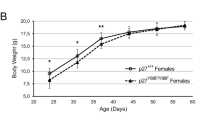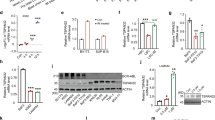Abstract
Bcr-Abl acquires its transforming ability through its upregulated Abl tyrosine kinase activity. Bcr is a phosphoprotein with a novel serine/threonine kinase activity encoded by its first exon. In chronic myelogenous leukemia (CML) cells, Bcr-Abl phosphorylates Bcr on tyrosine residues reducing its kinase activity. Overexpression of BCR in BCR-ABL+ cells produces a phosphoserine form of Bcr, which inhibits the oncogenic effects of BCR-ABL. To investigate the inhibitory effects of Bcr on Bcr-Abl, we expressed BCR/GFP in TonB210 cells, which contain a tetracycline-inducible BCR-ABL. In nude mice injected with cell clones of TonB210/BCR/GFP, tumor formation was delayed, and tumors were 50% smaller compared with the TonB210/GFP. In addition, TonB210/ BCR/GFP cells had little colony-forming ability in soft agar compared with TonB210/GFP cells. In contrast, a point mutant of BCR (Y360F), which disrupts its kinase activity, not only blocked Bcr's inhibitory effects but also enhanced the oncogenic effects of Bcr-Abl in a solid tumor model and in soft agar colony assays. Similar effects were observed with a second BCR kinase domain mutant, S354A. These results indicate that the inhibitory function of Bcr directed toward Bcr-Abl requires its kinase function.
This is a preview of subscription content, access via your institution
Access options
Subscribe to this journal
Receive 50 print issues and online access
$259.00 per year
only $5.18 per issue
Buy this article
- Purchase on Springer Link
- Instant access to full article PDF
Prices may be subject to local taxes which are calculated during checkout





Similar content being viewed by others
References
Abe J, Kusuhara M, Ulevitch RJ, Berk BC, Lee JD . (1996). Big mitogen-activated protein kinase 1 (BMK1) is a redox-sensitive kinase. J Biol Chem 271: 16586–16590.
Arlinghaus RB . (2002). BCR: a negative regulator of the Bcr-Abl oncoprotein in leukemia. Oncogene 21: 8560–8567.
Daley GQ, Baltimore D . (1988). Transformation of an interleukin 3-dependent hematopoietic cell line by the chronic myelogenous leukemia-specific P210bcr/abl protein. Proc Natl Acad Sci USA 85: 9312–9316.
Guo JQ, Lian JY, Xian YM, Lee M-S, Deisseroth AB, Stass SA et al. (1994). BCR-ABL protein expression in peripheral blood cells of chronic myelogenous leukemia patients undergoing therapy. Blood 83: 3629–3637.
Hawk N, Sun T, Xie S, Wang Y, Wu Y, Liu J et al. (2002). Inhibition of the BCR-ABL oncoprotein by BCR requires phosphotyrosine 354. Cancer Res 62: 386–390.
Klucher KM, Lopez DV, Daley GQ . (1998). Secondary mutation maintains the trasnformation state in BaF3 cells with inducible BCR-ABL expression. Blood 91: 3927–3934.
Li WJ, Dreazan O, Kloetzer W, Gale RP, Arlinghaus RB . (1989). Characterization of the bcr gene products in hematopoietic cells. Oncogene 4: 127–138.
Lin F, Monaco G, Sun T, Liu J, Lin H, Stephens C et al. (2001). BCR gene expression blocks Bcr-Abl induced pathogenicity in a mouse model. Oncogene 20: 1873–1881.
Ling X, Ma G, Sun T, Liu J, Arlinghaus RB . (2003). Bcr and Abl interaction. Oncogenic activation of c-Abl by sequestering Bcr. Cancer Res 63: 298–303.
Liu J, Campbell M, Guo JQ, Lu D, Xian YM, Anderson BS et al. (1993). BCR-ABL tyrosine kinase is autophosphorylated or transphosphorylates P160 BCR on tyrosine predominantly within the first BCR exon. Oncogene 1: 101–109.
Liu J, Wu Y, Ma GZ, Lu D, Haataja L, Heisterkamp N et al. (1996). Inhibition of BCR serine kinase by tyrosine phosphorylation. Mol Cell Biol 3: 998–1005.
Lu D, Liu J, Campbell M, Guo JQ, Heisterkamp N, Groffen J et al. (1993). Tyrosine phosphorylation of P160 BCR by P210 BCR-ABL. Blood 82: 1257–1263.
Mahon GM, Wang Y, Korus M, Kostenko E, Cheng L, Sun T et al. (2003). The c-Myc oncoprotein interacts with Bcr. Curr Biol 5: 437–441.
Maru Y, Witte ON . (1991). The BCR gene encodes a novel serine/threonine kinase activity within a single exon. Cell 67: 459–468.
McWhirter JR, Galasso DL, Wang JY . (1993). A coiled-coil oligomerization domain of BCR is essential for the transforming function of BCR-ABL oncoproteins. Mol Cell Biol 13: 7587–7595.
Moravcová J, Regner J, Moučková D, Fis̆er K, Zmeková V, Maláčová R et al. (2005). Disease status in patients with chronic myeloid leukemia is better characterized by BCR-ABL/BCR transcript ratio than by BCR-ABL transcript level, which may suggest a role for normal BCR gene in the disease pathogenesis. Neoplasma 52: 119–125.
Nagar B, Hantschel O, Seeliger M, Davies JM, Weis WI, Superti-Furga G et al. (2006). Organization of the SH3-SH2 unit in active and inactive forms of the c-Abl tyrosine kinase. Mol Cell 21: 787–798.
Pendergast AM, Muller AJ, Havlik MH, Maru Y, Witte ON . (1991). BCR sequences essential for transformation by the BCR-ABL oncogene bind to the ABL SH2 regulatory domain in a non-phosphotyrosine-dependent manner. Cell 66: 161–171.
Ress A, Moelling K . (2005). Bcr is a negative regulator of the Wnt signaling pathway. EMBO Rep 11: 1095–1100.
Sawyers CL, Callahan W, Witte ON . (1992). Dominant negative MYC blocks transformation of ABL oncogenes. Cell 70: 901–910.
Stam K, Heisterkamp N, Reynolds Jr FH, Groffen J . (1987). Evidence that the phl gene encodes a 160 000-dalton phosphoprotein with associated kinase activity. Mol Cell Biol 5: 1955–1960.
Wu Y, Ma G, Lu D, Lin F, Xu HJ, Liu J et al. (1999). BCR: a negative regulator of the Bcr-Abl oncoprotein. Oncogene 18: 4416–4424.
Xie S, Lin H, Sun T, Arlinghaus RB . (2002). Jak2 is involved in c-Myc induction of Bcr-Abl. Oncogene 21: 7137–7146.
Acknowledgements
This research was supported in part by Grant CA49639 and by funds from the Hendrick Marrow Foundation.
Author information
Authors and Affiliations
Corresponding author
Rights and permissions
About this article
Cite this article
Perazzona, B., Lin, H., Sun, T. et al. Kinase domain mutants of Bcr enhance Bcr-Abl oncogenic effects. Oncogene 27, 2208–2214 (2008). https://doi.org/10.1038/sj.onc.1210851
Received:
Revised:
Accepted:
Published:
Issue Date:
DOI: https://doi.org/10.1038/sj.onc.1210851



